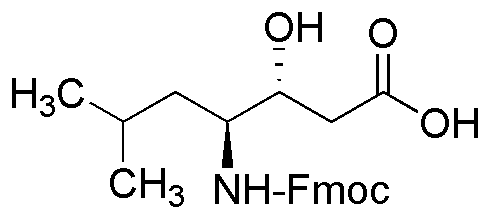Fmoc-(3R,4S)-4-amino-3-hydroxy-6-methyl-heptanoic acid is widely utilized in research focused on:
- Peptide Synthesis: This compound serves as a key building block in the synthesis of peptides, particularly in solid-phase peptide synthesis (SPPS), allowing for the creation of complex peptide sequences efficiently.
- Drug Development: Its unique structure makes it valuable in the design of novel pharmaceuticals, especially in the development of peptide-based drugs that target specific biological pathways.
- Bioconjugation: The compound can be used to create bioconjugates, linking peptides to other molecules like drugs or imaging agents, enhancing their efficacy and specificity in therapeutic applications.
- Research in Neuroscience: It is utilized in studies related to neuropeptides, helping researchers understand their role in neurological functions and potential treatments for neurodegenerative diseases.
- Custom Synthesis: Laboratories often use this compound for custom synthesis projects, providing tailored solutions for specific research needs in various fields, including biotechnology and molecular biology.
General Information
Properties
Safety and Regulations
Applications
Fmoc-(3R,4S)-4-amino-3-hydroxy-6-methyl-heptanoic acid is widely utilized in research focused on:
- Peptide Synthesis: This compound serves as a key building block in the synthesis of peptides, particularly in solid-phase peptide synthesis (SPPS), allowing for the creation of complex peptide sequences efficiently.
- Drug Development: Its unique structure makes it valuable in the design of novel pharmaceuticals, especially in the development of peptide-based drugs that target specific biological pathways.
- Bioconjugation: The compound can be used to create bioconjugates, linking peptides to other molecules like drugs or imaging agents, enhancing their efficacy and specificity in therapeutic applications.
- Research in Neuroscience: It is utilized in studies related to neuropeptides, helping researchers understand their role in neurological functions and potential treatments for neurodegenerative diseases.
- Custom Synthesis: Laboratories often use this compound for custom synthesis projects, providing tailored solutions for specific research needs in various fields, including biotechnology and molecular biology.
Documents
Safety Data Sheets (SDS)
The SDS provides comprehensive safety information on handling, storage, and disposal of the product.
Product Specification (PS)
The PS provides a comprehensive breakdown of the product’s properties, including chemical composition, physical state, purity, and storage requirements. It also details acceptable quality ranges and the product's intended applications.
Certificates of Analysis (COA)
Search for Certificates of Analysis (COA) by entering the products Lot Number. Lot and Batch Numbers can be found on a product’s label following the words ‘Lot’ or ‘Batch’.
*Catalog Number
*Lot Number
Certificates Of Origin (COO)
This COO confirms the country where the product was manufactured, and also details the materials and components used in it and whether it is derived from natural, synthetic, or other specific sources. This certificate may be required for customs, trade, and regulatory compliance.
*Catalog Number
*Lot Number
Safety Data Sheets (SDS)
The SDS provides comprehensive safety information on handling, storage, and disposal of the product.
DownloadProduct Specification (PS)
The PS provides a comprehensive breakdown of the product’s properties, including chemical composition, physical state, purity, and storage requirements. It also details acceptable quality ranges and the product's intended applications.
DownloadCertificates of Analysis (COA)
Search for Certificates of Analysis (COA) by entering the products Lot Number. Lot and Batch Numbers can be found on a product’s label following the words ‘Lot’ or ‘Batch’.
*Catalog Number
*Lot Number
Certificates Of Origin (COO)
This COO confirms the country where the product was manufactured, and also details the materials and components used in it and whether it is derived from natural, synthetic, or other specific sources. This certificate may be required for customs, trade, and regulatory compliance.


